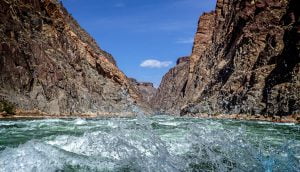
Before the Colorado River enters Lake Powell and above the Grand Canyon is Cataract Canyon. Cataract Canyon is located in southeastern Utah and is a part of Canyonlands National Park. This section of Colorado River rafting is famous for its incredible rapids and stunning scenery. The area is a landscape full of sandstone canyons, grabens, buttes, and mesas. Cataract Canyon starts at the confluence of the Green and Colorado Rivers, with the rivers dividing Canyonlands National Park into three distinct and unique sections. Between the two rivers is the Island in the Sky District, here one can find incredible views, arches, and slickrock. On the west side of the Green River is the Maze district. This area is full of winding canyons and ancient rock art. On the East side of the Colorado River is the Needles District full of spires, grabens, and even more ancient rock art. One could spend a lifetime in Canyonlands and just scratch the surface of the place.
Rafting Cataract Canyon is a great way to explore Canyonlands National Park. Most trips start on the Colorado River south of Moab at the Potash Boat Ramp and are 3-5 days in length. After hearing a safety talk and being fitted with life jackets rafters board the rafts and head down river. After a short ride on the rafts boaters enter Canyonlands National Park. After lunch the first day there is a great spot to explore a petrified forest. There are numerous huge trees that have been preserved by being knocked over and covered by mud before oxygen could decompose them. The next popular stop is Lathrop Canyon. This is a great spot to see some Native American pictographs that were painted on the sandstone hundreds of years ago. Most trips camp in this area the first night.
The second day of the trip rafters will get the opportunity to see multiple Native American Granaries which were built to store food in. The next hike ones comes to on the river is Indian Creek, which in the spring offers a great opportunity to hike to a beautiful waterfall in a narrow canyon. After a few more miles on the river there is an opportunity to hike over the Loop. The Loop is a place where the river has made a sharp turn and almost come completely back upon itself. This allows those who feel like hiking to hike over a saddle of sandstone and meet the boats on the other side. After a hike over the Loop it is time to relax and enjoy the scenery. Next the Green River joins the Colorado River and Cataract Canyon officially starts. Trips usually camp just below the first rapid in Cataract Canyon which is called Brown Betty. Here there is one of the most beautiful sand beaches on the entire Colorado River system. This marks the turning point of the calm water to raging whitewater of Cataract Canyon. This section of rapids during flows above 50,000 cfs has rapids that make the famous rapids of the Grand Canyon seem small.
The next morning offers a great opportunity to hike into the “Doll’s House” of Canyonlands National Park. This is a very strenuous hike, but if one has the time and the weather is not too hot it is a great place to see. The best way to describe it would be a palace made of red stone with secret passages and rooms. It would be something Martian royalty might have. Besides the “Doll’s House,” the scenery is amazing and one can get a view of the skyline in all directions and see all the great geology of the area caused by salt, wind, water, and long periods of time.
After returning from the Doll’s House it is time for Colorado River rafting through Cataract Canyon. The rapids start small but grow quickly, and before you know it you are in Mile Long, Ben Hurt, The Big Drops, and Waterhole. At low water, these rapids require great skill to maneuver through the huge sandstone boulders, at high water the waves routinely reach 10-15 feet high trough to crest. After Waterhole Rapid the effects of Lake Powell start to rear their head. The rapids below this point are covered in silt. Huge sandbanks full of dead trees on each side of the river block ones view of the sandstone. This is another place where the geology is happening. This time rapidly. Lake Powell has only been around for about 50 years. In this short amount of time, sand has been deposited as the current slowed, and the river entered the lake. Currently, the lake is less than 50% capacity and the outlook for filling the lake is not good. The Western United States is in a drought and an increasing population is demanding more and more water that the Colorado River can not supply.
For more information about Colorado River rafting contact Colorado River & Trail Expeditions(www.crateinc.com). In addition to running Cataract Canyon they also operate commercial rafting trips






